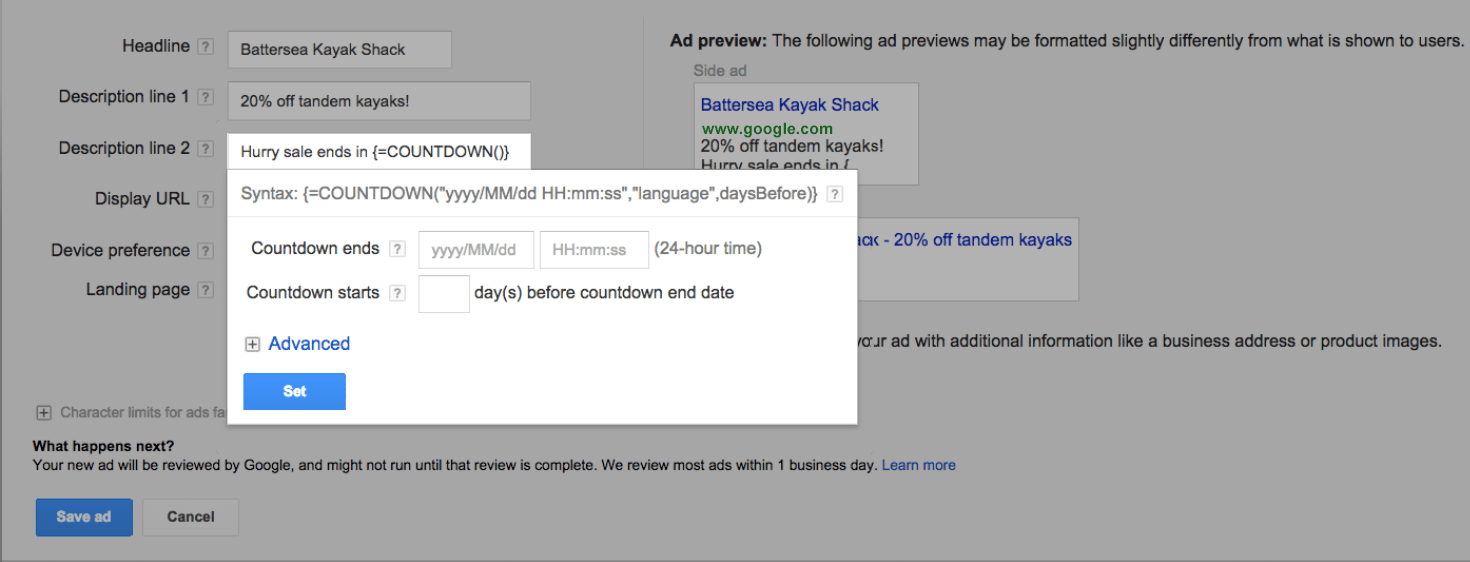Although Google ad customizers have been around a few years, the introduction of user-friendly “IF” customizers for text ads brought a new spotlight to the feature in 2017. The digital advertising community warmly welcomed the opportunity to customize ad messaging without requiring the preparation and upload of a business data feed.
AdWords IF Functions are the newest member of the ad customizer team, but other longstanding members also deserve recognition. Today, we will explore the What, the When, and the How of implementing ad customizers to maximize your Search network success.
What are ad customizers?
Ad customizers allow you to dynamically adjust portions of your ad messaging in response to specific signals from your audience. For example, you may want to show different copy to a user on mobile vs. desktop, or to someone who has already purchased from your site vs. a new user who has never engaged with you online.
You may have even seen or used ad customizers without realizing it.
Dynamic Keyword Insertion (DKI), which is used to place keywords into ad text on a query-by-query basis, is a commonly used and rarely acknowledged member of the customizer family. DKI is a simple way to increase ad relevancy (think: Quality Score and CTR) by showing very specific text ads without having to create and manage hundreds or thousands of SKAGs.
To demonstrate, Google’s own documentation on keyword insertion shows us that the headline “Buy {KeyWord: Chocolate}” might trigger ads such as:

Countdown ad customizers (also called “Countdown Ads”) are a slightly more complex variety that inserts the number of days or hours remaining before a specified deadline. These are great for sales and promotions by online vendors or upcoming application deadlines. Advertisers input the deadline (or end date and time), desired language, and countdown start (number of days before deadline) directly into the ad — no supplemental feeds required:

The psychological impact of a countdown creates urgency in the user’s mind — persuading them to take action now. (It works the same way on post-click landing pages, for example, because the countdown timer encourages people to convert before the offer expires.)
IF Function customizers, as mentioned, are the latest feedless customizer option. Like IF functions in Excel, a criterion is inserted based on device type or audience list name. If the criterion is met, then the associated ad text is inserted into the copy. If the criterion is not met, the default ad text will show.
For example, users shopping on mobile could be shown a “Shop On Your Phone” CTA rather than the standard desktop headline:


It should be noted that DKI, Countdown, and IF Function ads are all limited to a single criterion for customized text insertion. To dynamically adjust aspects of your copy with multiple criteria, a business data feed is required.
Parameter customizers, such as Geo or Product Type/Inventory customizers, are the most technical and flexible options in AdWords. Parameters can be used to replace multiple elements within a single ad, so long as those elements or parameters are defined within a Business Data Feed in the AdWords account.
For instance, take the below example of a data feed uploaded into AdWords.

This feed could be used to create an ad that dynamically updates the Type, Price and Count each time the ad appears.

A full list of suggested attributes (and instructions for data feed preparation) can be found here.
When should I use ad customizers?
As you may be feeling by now, ad customizers are a powerful tool in the hands of a skilled PPC manager. They save time and energy by eliminating the need for duplicate ads, ad groups, and campaigns. They can both directly and indirectly improve account performance by increasing the relevance or urgency of your ad messaging.
However, we know that “with great power comes great responsibility,” and savvy PPC folk should approach ad customizers in the same respect. While customizers can be a great asset to your account’s text ad copy, you must also ensure you are using the best customizer to match your needs.
Scenario 1: Black Friday for online sales
Let’s say you have an online version of your store (or perhaps you sell completely online) and want to gear up for the holiday season. You know that Black Friday is a heavy traffic day but you want to let users know that your “Black Friday Sale” isn’t limited to Friday only.
What to consider: You want to reach users before the sale begins to capture and retain attention. Once the sale begins though, you want users to feel a sense of urgency to complete their purchase.
How to use customizers: Craft two sets of ad messaging using Countdown ad customizers.
- Before the sale begins, inform users of its impending arrival (e.g. “2 days to Black Friday Sales – Beat the Rush & Start Shopping Now!”).
- While the sale runs, increase urgency by informing searchers of diminishing time to complete their purchase (e.g. “Black Friday Prices Are Here – Only 23 hours to Save!”).
Scenario 2: National chain with local targeting
Let’s now consider a non-holiday example. Say you’re advertising on behalf of a national chain which has local targeting (by state or city) and you want to mention the location name in your ad copy without having to duplicate your campaigns or ad groups.
What to consider: Account structure is an important consideration. Are multiple locations nested in a single campaign or do campaign names reflect the location target? You will need to upload your ad customizer data utilizing the “Target campaign” or “Target location” attributes. We recommend the latter as an added layer of security in case there is any gap or discrepancy among the campaign names.
How to use customizers: Upload your ad customizer data using the Target location attribute and your desired text for each location. This might be a single item, such as the location name, or a full line of text.
Using the above feed, we could structure our headline in two ways:
- “{=LocationFeed.Headline}” >> Fill with text from the Headline column for each target location match
- “Plumbing Services in {=LocationFeed.Location}” >> Fill with text from the Location column for each target location match
Scenario 3: High volume and CPA on mobile
Finally, let’s look at an account where a high volume of traffic comes through mobile searches but where mobile CPA is higher than desktop. This could signal that the device-neutral ad copy is misaligning searcher expectations with what meets them on the mobile post-click landing page.
What to consider: What aspects of the mobile conversion process are different from that of a desktop conversion? Maybe the form submission or checkout process is not mobile-friendly. Maybe mobile users are in a research or consideration mindset and not ready to complete a conversion. If so, the mobile copy could be adjusted with these differences in mind.
How to use customizers: Apply “IF” customizers for users searching on mobile with a CTA that aligns with mobile post-click landing page expectations (e.g. “Call Now” vs. “Sign Up”) or calls out device compatibility (e.g. “Simple Mobile Checkout” or “Buy From Your Phone”).
There is no hard-and-fast rule for which customizers to use, and multiple types can be used in conjunction (i.e. DKI in headline, Countdown in headline, IF functions in description line, etc.). Nevertheless, we’ve built this nifty table to help guide your customizer decisions.

How do I implement ad customizers?
Once you know the ad customizer you want to use, it’s time to take the leap and implement (eek!). Fear not — just follow the guidelines below. Feed preparation guidance, as noted above, can be found on Google’s Support pages.

Implementing ad customizers can seem intimidating. Admittedly, it does take a bit of strategic effort on the front end, especially if you plan to implement across many ad groups simultaneously or if you are mixing multiple feed parameters into your copy. Whichever customizers you take on, it is wise to upload using the AdWords Editor. Editor will notify you of syntax errors (if any) and prevent the headache of trying to troubleshoot an unsuccessful bulk upload.
Your first time tackling a major ad customizer project, you should consider breaking it into pieces (one or a few campaigns at a time, to begin). The more you practice your syntax and feed data skills, the more confident you will feel. In no time, you’ll be an ad customizer pro passing your knowledge on to the next PPC generation.
Level up your ad copy game
Hopefully, by now, you are feeling both excited and empowered to start utilizing ad customizers more effectively in your PPC accounts. AdWords is continually bringing new offerings to the table, so we may not be far from even more ad customization opportunities down the road. In the meantime, there are 3 things to remember as you start leveling up your ad copy game:
- Ad customizers are not a big scary beast — every PPC manager can learn and effectively utilize ad customizers to increase relevancy and campaign performance.
- The key to effective ad customization is to understand your objective and choose the customizer(s) that best fit(s) your needs.
- Uploading customized ads through AdWords Editor can help troubleshoot syntax errors and provide a clean upload (with labels, too, if desired).
With this advanced targeting feature, you’d be silly not to take advantage of it. Not only do ad customizers allow you to target your audience more precisely, they are easy to setup and manage, too. Once you’re setup, ensure that you’re converting as many ad clicks as possible by directing your traffic to dedicated post-click landing pages. Your conversion rate will thank you.
